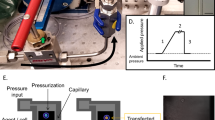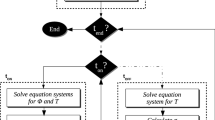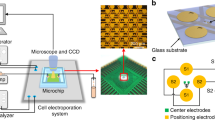Abstract
Although electroporation is widely used for laboratory gene transfection and gaining increased importance for nonviral gene therapy, it is generally employed using trial-and-error optimization schemes for lack of methods to predict electroporation's effects on cells. Therefore, we used a statistical approach to quantitatively predict molecular uptake and cell viability following electroporation and show that it predicts both in vitro and in vivo results for a wide range of molecules, including DNA, in 60 different cell types. Mechanistically, this broad predictive ability suggests that electroporation is mediated primarily by lipid bilayer structure and only secondarily by cell-specific characteristics. For gene therapy applications, this approach should facilitate rational design of electroporation protocols. Gene Therapy (2001) 8, 1464–1469.
This is a preview of subscription content, access via your institution
Access options
Subscribe to this journal
Receive 12 print issues and online access
$259.00 per year
only $21.58 per issue
Buy this article
- Purchase on Springer Link
- Instant access to full article PDF
Prices may be subject to local taxes which are calculated during checkout



Similar content being viewed by others
References
Chang DC, Chassy BM, Saunders JA, Sowers AE (eds) . Guide to Electroporation and Electrofusion Academic Press: New York 1992
Nickoloff JA (ed . ). Animal Cell Electroporation and Electrofusion Protocols Humana Press: Totowa, NJ 1995
Nickoloff JA (ed . ). Plant Cell Electroporation and ElectrofusionProtocols Humana Press: Totowa, NJ 1995
Nickoloff JA (ed . ). Electroporation Protocols for Microorganisms Humana Press: Totowa, NJ 1995
Lynch PT, Davey MR (ed . ). Electrical Manipulation of Cells Chapman and Hall: New York 1996
Heller R, Gilbert R, Jaroszeski MJ . Clinical applications of electrochemotherapy Adv Drug Deliv Rev 1999 35: 119–129
Jaroszeski MJ, Gilbert R, Nicolau C, Heller R . In vivo gene delivery by electroporation Adv Drug Deliv Rev 1999 35: 131–138
Jaroszeski MJ, Heller R, Gilbert R (eds) . Electrochemotherapy, Electrogenetherapy, and Transdermal Drug Delivery Humana Press: Totowa, NJ 2000
Prausnitz MR . A practical assessment of transdermal drug delivery by skin electroporation Adv Drug Deliv Rev 1999 35: 61–76
Canatella PJ, Karr JF, Petros JA, Prausnitz MR . Quantitative study of electroporation-mediated molecular uptake and cell viability Biophys J 2001 80: 755–764
Prausnitz MR et al. A quantitative study of electroporation showing a plateau in net molecular transport Biophys J 1993 65: 414–422
Prausnitz MR et al. Quantitative study of molecular transport due to electroporation: uptake of bovine serum albumin by erythrocyte ghosts Biophys J 1994 66: 1522–1530
Gift EA, Weaver JC . Observation of extremely heterogeneous electroporative molecular uptake by Saccharomyces cervisiae which changes with electric field pulse amplitude Biochim Biophys Acta 1995 1234: 52–62
Chizmadzhev YA, Zarnytsin VG, Weaver JC, Potts RO . Mechanism of electroinduced ionic species transport though a multilamellar lipid system Biophys J 1995 68: 749–765
Weaver JC, Chizmadzhev YA . Theory of electroporation: a review Bioelectrochem Bioenerg 1996 41: 135–160
Hogg VG, Ledolter J . Applied Statistics for Engineers and Physical Scientists Macmillan: New York 1992
Chu G, Hayakawa H, Berg P . Electroporation for the efficient transfection of mammalian cells with DNA Nucleic Acids Res 1987 15: 1311–1326
Knutson JC, Yee D . Electroporation: parameters affecting transfer of DNA into mammalian cells Anal Biochem 1987 164: 44–52
Stopper H, Jones H, Zimmermann U . Large scale transfection of mouse L-cells by electropermeabilization Biochim Biophys Acta 1987 900: 38–44
Cann AJ, Koyanagi Y, Chen ISY . High efficiency transfection of primary human lymphocytes and studies of gene expression Oncogene 1988 3: 123–128
McNally MA, Lebkowski JS, Okarma TB, Lerch LB . Optimizing electroporation parameters for a variety of hematopoietic cell lines Biotechniques 1988 6: 882–886
Shigekawa K, Dower WJ . Electroporation of eukaryotes and prokaryotes: a general approach to the introduction of macromolecules into cells Biotechniques 1988 6: 742–751
Andreason GL, Evans GA . Optimization of electroporation for transfection of mammalian cell lines Anal Biochem 1989 180: 269–275
Anderson MLM, Spandidos DA, Coggins JR . Electroporation of lymphoid cells: factors affecting the efficiency of transfection J Biochem Biophys Meth 1991 22: 207–222
Takahashi M et al. Gene transfer into human leukemia cell lines by electroporation: experience with exponentially decaying and square wave pulse Leukemia Res 1991 15: 507–513
Baum C, Forster P, Hegewisch-Becker S, Harbers K . An optimized electroporation protocol applicable to a wide range of cell lines Biotechniques 1994 17: 1058–1062
Kotnis RA et al. Optimisation of gene transfer into vascular endothelial cells using electroporation Eur J Vasc Endovasc Surg 1995 9: 71–79
Canatella P . Control and Optimization of Electroporation-Mediated Drug and Gene Delivery PhD thesis, Georgia Institute of Technology: Atlanta, GA 2000
Bazile D, Mir LM, Paoletti C . Voltage-dependent introduction of a d[α]octothymidylate into electropermeabilized cells Biochem Biophys Res Com 1989 159: 633–639
Okamoto H et al. Optimization of electroporation for transfection of human fibroblast cell lines with origin-defective SV40 DNA: development of human transformed fibroblast cell lines with mucopolysaccharidoses (I-VII) Cell Struct Funct 1992 17: 123–128
Brüggemann U, Roux EC, Hannig J, Nicolau C . Low-oxygen-affinity red cells produced in large-volume, continuous-slow electroporation system Transfusion 1995 35: 478–486
Rols MP, Femenia P, Teissie J . Long-lived macropinocytosis takes place in electropermeabilized mammalian cells Biochem Biophys Res Com 1995 208: 26–35
Sukhorukov VL et al. Electropermeabilization and fluorescent tracer exchange: the role of whole-cell capacitance Cytometry 1995 21: 230–240
Cemazar M et al. Effect of electric-field intensity on electropermeabilization and electrosensitivity of various tumor-cell lines in vitro Electro Magnetobiol 1998 17: 263–270
Golzio M et al. Control by osmotic pressure of voltage-induced permeabilization and gene transfer in mammalian cells Biophys J 1998 74: 3015–3022
Lebar AM . Significance of treatment energy in cell electropermeabilization Electro Magnetobiol 1998 17: 255–262
Neumann E et al. Mechanism of electroporative dye uptake by mouse B cells Biophys J 1998 74: 98–108
Rols M, Teissie J . Electropermeabilization of mammalian cells to macromolecules: control by pulse duration Biophys J 1998 75: 1415–1423
Weaver JC et al. Electroporation: high frequency of occurrence of a transient high-permeability state in erythrocytes and intact yeast FEBS Lett 1998 229: 30–34
Xie TD, Sun L, Tsong TY . Study of mechanisms of electric field-induced DNA transfection I: DNA entry by surface binding and diffusion through membrane pores Biophys J 1990 58: 13–19
Mack K, Titball RW . Transformation of Burkholderia pseudomallei by electroporation Anal Biochem 1996 242: 73–76
Jost BH, Billington SJ, Songer JG . Electroporation-mediated transformation of Arcanobacterium (Actinomyces) pyogenes Plasmid 1997 38: 135–140
Kalscheuer R, Arenskötter M, Steinbüchel A . Establishment of a gene transfer system for Rhodococcus opacus PD630 based on electroporation and its application for recombinant biosynthesis of poly(3-hydroxyalkanoic acids) Appl Microbiol Biotechnol 1999 52: 508–515
Heller R et al. In vivo gene electroinjection and expression in rat liver FEBS Lett 1996 389: 225–228
Aihara H, Miyazaki J . Gene transfer into muscle by electroporation in vivo Nature Biotech 1998 16: 867–870
Rols M et al. In vivo electrically mediated protein and gene transfer in murine melanoma Nature Biotech 1998 16: 168–171
Suzuki T et al. Direct gene transfer into rat liver cells by in vivo electroporation FEBS Lett 1998 425: 436–440
Gehl J, Mir LM . Determination of optimal parameters for in vivo gene transfer by electroporation, using a rapid in vivo test for cell permeabilization Biochem Biophys Res Commun 1999 261: 377–380
Pliquett U, Gift EA, Weaver JC . Determination of the electric field and anomalous heating caused by exponential pulses with aluminum electrodes in electroporation experiments Bioelectrochem Bioenerg 1996 39: 39–53
Acknowledgements
We would like to thank Dr Russell Heikes for help with statistical analysis and Derek Atkinson and Conor McKenna for technical assistance. This work was supported in part by a National Science Foundation CAREER award, the Emory/Georgia Tech Biomedical Technology Research Center, Cyto Pulse Sciences, Inc. and the Dow Minority Research Program.
Author information
Authors and Affiliations
Rights and permissions
About this article
Cite this article
Canatella, P., Prausnitz, M. Prediction and optimization of gene transfection and drug delivery by electroporation. Gene Ther 8, 1464–1469 (2001). https://doi.org/10.1038/sj.gt.3301547
Received:
Accepted:
Published:
Issue Date:
DOI: https://doi.org/10.1038/sj.gt.3301547
Keywords
This article is cited by
-
Genetic Modification of Mesenchymal Stem Cells for Neurological Disease Therapy: What Effects Does it Have on Phenotype/Cell Behavior, Determining Their Effectiveness?
Molecular Diagnosis & Therapy (2020)
-
Exosomes and their Application in Biomedical Field: Difficulties and Advantages
Molecular Neurobiology (2018)
-
Repeated photoporation with graphene quantum dots enables homogeneous labeling of live cells with extrinsic markers for fluorescence microscopy
Light: Science & Applications (2018)
-
Synergistic combinations of short high-voltage pulses and long low-voltage pulses enhance irreversible electroporation efficacy
Scientific Reports (2017)
-
Direct and sustained intracellular delivery of exogenous molecules using acoustic-transfection with high frequency ultrasound
Scientific Reports (2016)



